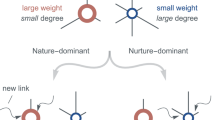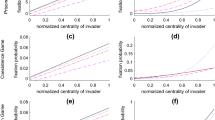Abstract
Studying an evolving complex system and drawing some conclusions from it is an integral part of nature-inspired computing; being a part of that complex system, some insight can also be gained from our knowledge of it. In this paper we study the evolution of the evolutionary computation co-authorship network using social network analysis tools, with the aim of extracting some conclusions on its mechanisms. In order to do this, we first examine the evolution of macroscopic properties of the EC co-authorship graph, and then we look at its community structure and its corresponding change along time. The EC network is shown to be in a strongly expansive phase, exhibiting distinctive growth patterns, both at the macroscopic and the mesoscopic level.










Similar content being viewed by others
Notes
http://www.informatik.uni-trier.de/∼ley/db/
To give an idea of the breadth of the search, the initial seed contains 2,967 authors, and the final network comprises 6,555 authors.
Volatility figures for recent years have to be interpreted as upper bounds, since the time window for considering that an author has left the field gets narrower as we approach current year.
References
Barabási, A.L., Albert, R.: Emergence of scaling in random networks. Science 286, 509–512 (1999)
Barabási, A.L., Jeong, H., Neda, Z., Ravasz, E., Schubert, A., Vicsek, T.: Evolution of the social network of scientific collaborations. Physica. A. 311(3), 590–614 (2002)
Borgatti, S.P., Everett, M.G.: Models of core/periphery structure. Soc. Networks. 21, 375–395 (1999)
Cotta, C., Merelo, J.J.: The complex network of EC authors. SIGEvolution 1(2), 2–9 (2006)
Dorogovtsev, S.N., Mendes J.F.F.: Evolution of networks: From biological nets to the Internet and WWW. Oxford University Press, (2003)
Girvan, M., Newman M.E.J.: Community structure in social and biological networks. Proc. Natl. Acad. Sci. USA 99, 7821–7826 (2002)
Glanzel, W. Coauthorship patterns and trends in the sciences: a bibliometric study with implications for database indexing and search strategies 1980–1998 Library Trends, 50(3), 2002
Grossman, J.W.: Patterns of collaboration in mathematical research. SIAM News 35(9), 8–9 (2002) November
Horn, D.B., Finholt, T.A., Birnholtz, J.P., Motwani, D., and Jayaraman, S.. Six degrees of Jonathan Grudin: a social network analysis of the evolution and impact of CSCW research. In CSCW ’04: Proceedings of the 2004 ACM conference on Computer supported cooperative work, pages 582–591, New York, NY, USA, 2004. ACM Press.
Jeong, H., Neda, Z., Barabási, A.L.: Measuring preferential attachment in evolving networks. Europhys. Lett. 61(4), 567–572 (2003)
Kretschmer, H.: Coauthorship networks of invisible collees and institutional communities. Scientometrics 31(1), 363–369 (1994)
Kretschmer, H.: Patterns of behaviour in coauthorship networks of invisible colleges. Scientometrics 40(3), 579–591 (1997)
Luukkonen, T., Persson, O., and Sivertsen, G.: Understanding patterns of international scientific collaboration. Science Technol. Human Values 17(1), 101–126 (1992)
Merelo, J.J., Cotta, C.: Building bridges: The role of subfields in metaheuristics. SIGEvolution 1(4), 9–15 (2007)
Newman, M.E.J.: The structure and function of complex networks. SIAM Review. 45, 167–256 (2003)
Newman, M.E.J.: Detecting community structure in networks. Euro Phys. J. B. 38, 321–330 (2004)
Newman, M.E.J., Girvan, M.: Finding and evaluating community structure in networks. Phys. Rev. E. 69, 026113 (2004)
Solé, R., Valverde, S.: Information theory of complex networks. In E. Ben-Naim, Frauenfelder, H., and Toroczkai, Z., editors, Complex Networks, Lecture Notes in Physics, pages 169–190. Springer-Verlag, (2004)
Sparrowe, R.T., Liden, R.C., Wayne, S.J., Kraimer, M.L.: Social networks and the performance of individuals and groups. Acad. Manag. J. 44(2), 316–325 (2001)
Tomassini, M., Luthi, L., Giacobini, M., Langdon, W.B.: The structure of the genetic programming collaboration network. Gene. Program. Evol. Machines 8, 97–103 (2007)
Watts, D.J., Strogatz, S.H.: Collective dynamics of ‘small-world’ networks. Nature 393:440–442 (1998)
Yoshikane, F., Kageura, K.: Comparative analysis of coauthorship networks of different domains: The growth and change of networks. Scientometrics 60(3), 433–444 (2004)
Acknowledgments
This work has been supported in part by MCyT projects TIC2003-09481-C04-04, and TIN2005-08818-C04-01. Thanks are due to Mark Newman for providing us with his code for the calculation of edge betweenness.
Author information
Authors and Affiliations
Corresponding author
Rights and permissions
About this article
Cite this article
Cotta, C., Merelo, JJ. Where is evolutionary computation going? A temporal analysis of the EC community. Genet Program Evolvable Mach 8, 239–253 (2007). https://doi.org/10.1007/s10710-007-9031-0
Received:
Revised:
Accepted:
Published:
Issue Date:
DOI: https://doi.org/10.1007/s10710-007-9031-0




